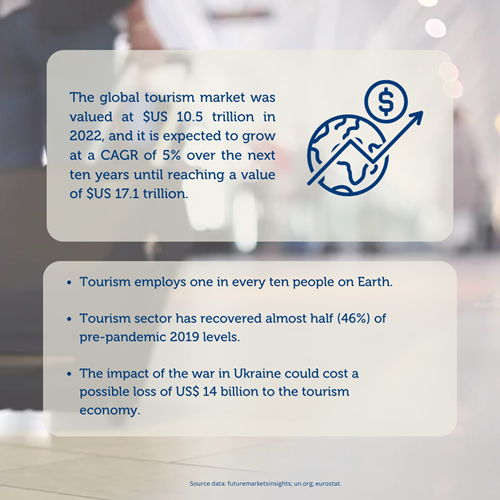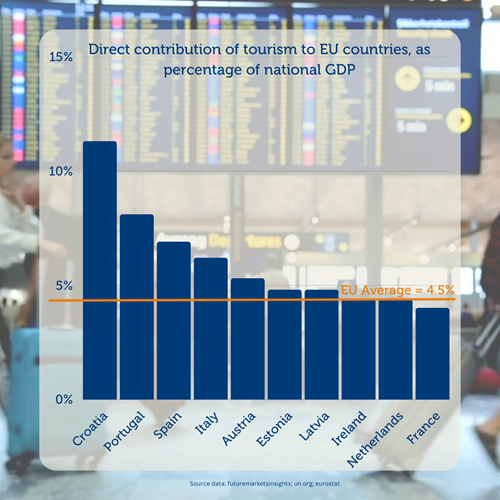Analysis and Studies - Studies
Global Market for Tourism: an inisght
August 1st 2023
The global tourism market reached a value of $10.5 trillion in 2022 and is projected to grow at a Compound Annual Growth Rate (CAGR) of 5% over the next decade. By 2032, it is estimated to be worth $17.1 trillion. While countries like Italy, France, Spain, and the United States remain popular tourist destinations, lesser-known African and Asian states have also become appealing to foreign tourists.
 At the beginning of 2022, international tourist arrivals doubled compared to 2021, and some regions have already surpassed pre-pandemic levels. The removal of travel restrictions and increasing consumer confidence are expected to drive the sector's recovery, providing hope and opportunities worldwide.
At the beginning of 2022, international tourist arrivals doubled compared to 2021, and some regions have already surpassed pre-pandemic levels. The removal of travel restrictions and increasing consumer confidence are expected to drive the sector's recovery, providing hope and opportunities worldwide.
The United Nations indicted an official World Tourism Day which is celebrated yearly on September 27th to recognize the tourism as a vital driver for development, and it has gained significant attention, including a special debate at the United Nations General Assembly in May 2022. Governments and international organizations worldwide are now actively discussing and promoting tourism and to make it even more sustainable.
Remarkably, one in every ten people on Earth is employed in the tourism industry. The sector has shown a strong rebound, with almost 250 million international arrivals in the first five months of 2022, recovering about 46% of pre-pandemic levels in 2019. Despite shared optimism, the ongoing war in Ukraine may have a significant impact, potentially resulting in a loss of $14 billion to the tourism economy.
 The EU's tourism industry consists of approximately 2.3 million businesses, primarily small and medium-sized enterprises (SMEs), providing holidays and tourism services. These businesses employ around 12.3 million people. In 2018, the direct contribution of the 'travel and tourism' sector to EU GDP was 3.9%, supporting around 5.1% of the total labor force (equivalent to about 11.9 million jobs). When considering its interconnections with other economic sectors, the tourism sector's impact expands significantly, contributing to 10.3% of GDP and employing 11.7% of the total workforce (equivalent to 27.3 million workers). In 2022, the EU average tourism contribution to the GDP was 4.5%, with countries like Croatia, Portugal, and Spain which were more heavily reliant on tourism compared to others. Other countries whose GDP is heavily influenced by tourism are: Italy, Austria, and Estonia.
The EU's tourism industry consists of approximately 2.3 million businesses, primarily small and medium-sized enterprises (SMEs), providing holidays and tourism services. These businesses employ around 12.3 million people. In 2018, the direct contribution of the 'travel and tourism' sector to EU GDP was 3.9%, supporting around 5.1% of the total labor force (equivalent to about 11.9 million jobs). When considering its interconnections with other economic sectors, the tourism sector's impact expands significantly, contributing to 10.3% of GDP and employing 11.7% of the total workforce (equivalent to 27.3 million workers). In 2022, the EU average tourism contribution to the GDP was 4.5%, with countries like Croatia, Portugal, and Spain which were more heavily reliant on tourism compared to others. Other countries whose GDP is heavily influenced by tourism are: Italy, Austria, and Estonia.
In 2019, there were 1.5 billion international tourist arrivals worldwide, with Europe accounting for 50% of the market, welcoming 745 million visitors. However, with the outbreak of the COVID-19 pandemic in March 2020, the tourism sector faced unprecedented challenges due to travel bans and health uncertainties.
Tourism policy in the EU not only supports the industry but also serves as a means to achieve broader employment and growth objectives. The importance of sustainable, responsible, and ethical tourism projects is increasing, with a growing focus on the environmental dimension of tourism. In 2020, the European Union Parliament adopted a resolution for a Sustainable Tourism within the European Union.
The countries which receive the most international visitors per year are mostly located within Europe, such as France, Spain, and Italy. Other countries such as China and the United States are also on the top five with Germany, Mexico, Turkey, the UK and Thailand in the top 10.
